L-class: Difference between revisions
Pbcjohnston (talk | contribs) Added L-9 photo and caption |
Pbcjohnston (talk | contribs) Added photos and captions |
||
| Line 84: | Line 84: | ||
=== <big>L-10 (Submarine No. 50, later SS-50)</big> === | === <big>L-10 (Submarine No. 50, later SS-50)</big> === | ||
[[File:L-10 Bantry Bay.jpg|left|500px|Library of Congress Collection.]] | |||
<div style="text-align: justify;"><span style="color:#00008B">The USS L-10, with the American “A” added to her fairwater to avoid confusion with the British L-class submarines, in Bantry Bay, Ireland. There is no date on the photo but the assumption is circa 1918. The L-10 was one of the best American subs working out of Ireland. | |||
LT Vincent Arthur Clarke, Jr. was sent for submarine training at New London, Connecticut. Upon graduation he was assigned to submarine duty and sent to the Azores. From there he was made the commanding officer of the L-10, probably relieving LT Newbold T. Lawrence Jr. as CO. The L-10 operated out of Bantry Bay, Ireland for the duration of the war. | |||
This command garnered Clarke a Navy Cross for his persistence in making the L-10 one of the "hot running boats" in WW I, racking up over 1700 hours out on patrol in pursuit of the enemy. War patrols in WW I were only an average of 10 days duration due to the sub's limits on food, water and fuel. | |||
LT Clarke is probably the officer on the bridge in this photo as the L-10 backs away from her mooring. The crew look to be stowing the mooring lines in preparation for possibly heading out on a war patrol looking for German submarines.</span> | |||
[[L-10|See more L-10 photos]] | [[L-10|See more L-10 photos]] | ||
[[File:Red bar sub.jpg]] | [[File:Red bar sub.jpg]] | ||
<div style="text-align: justify;"><span style="color:#000000"> | |||
=== <big>L-11 (Submarine No. 51, later SS-51)</big> === | === <big>L-11 (Submarine No. 51, later SS-51)</big> === | ||
</div> | |||
[[File:L-11 from port on trials.jpg|left|500px|Photo NH 51173 courtesy NHHC.]] | |||
<div style="text-align: justify;"><span style="color:#00008B">L-11 running builder's trials in Cape Cod Bay off Provincetown, MA., summer of 1916. She still has a pipe frame and canvas bridge structure. Most likely the boat is running at her full speed of 14 knots, testing the upper range of engine power.</span> | |||
[[L-11|See more L-11 photos]] | [[L-11|See more L-11 photos]] | ||
[[File:Red bar sub.jpg]] | [[File:Red bar sub.jpg]] | ||
<div style="text-align: justify;"><span style="color:#000000"> | |||
=== <big>General L-class & group photos</big> === | === <big>General L-class & group photos</big> === | ||
</div> | |||
[[File:2 L-Boats w-tender.jpg|left|500px|Photo in the private collection of Ric Hedman.]] | [[File:2 L-Boats w-tender.jpg|left|500px|Photo in the private collection of Ric Hedman.]] | ||
<div style="text-align: justify;"><span style="color:#00008B">Here we have here two unidentified L-class submarines. The unique shape of the bow planes pivot housings and the unique shaped “bullnose” on the tip of the bow are identifiers | <div style="text-align: justify;"><span style="color:#00008B">Here we have here two unidentified Eb design L-class submarines. The unique shape of the bow planes pivot housings and the unique shaped “bullnose” on the tip of the bow are identifiers of the EB design for this class. The two flat rectangular covers, one on top of the other over the bow planes pivots can be seen. This cover was unique to the L-1, L-2, L-3 and L-4 and then again with the L-9, L-10, and the L-11. Submarines L-5 through L-8 were built to the Lake Co. design and did not have these pivot covers. This variant of the L-class of submarine were commissioned by late 1916. The L-6 thru L-8 variant were commissioned in 1917. L-5 was commissioned in 1918. | ||
Both submarines have a tall forward radio mast. In looking in other archives we have seen only the L-1 with such a mast. So, possibly one of these two vessels could be the L-1 but it could just be coincidence that there only exists one image, other than this one, with these masts. Radio was new and trials were being made all the time. | Both submarines have a tall forward radio mast. In looking in other archives we have seen only the L-1 with such a mast. So, possibly one of these two vessels could be the L-1 but it could just be coincidence that there only exists one image, other than this one, with these masts. Radio was new and trials were being made all the time. | ||
Neither submarine have any sign of having | Neither submarine have any sign of having SC tube listening gear installed at this point. So, a possible date is closer to commissioning, perhaps a late 1916 or early 1917. But for sure this is before the U.S. entered WW I on April 6, 1917. The submarines still are using the old-fashioned pre-war canvas bridge shelters that proved too flimsy to withstand the pressures of diving with it erected. They were too time consuming to try and take down in actual war time conditions. | ||
The British, having been at war with Germany for two years, taught their American cousins a lot of practical things about actual submarine warfare including the development and use of the metal chariot bridge surround that could remain in place while diving and withstand those pressures. Soon almost all | The British, having been at war with Germany for two years, taught their American cousins a lot of practical things about actual submarine warfare including the development and use of the metal chariot bridge surround that could remain in place while diving and withstand those pressures. Soon almost all U.S. submarines had this revision installed. | ||
Once these subs reached Europe, the British, to avoid confusing their | Once these subs reached Europe, the British, to avoid confusing their L-class submarines with the American L-class, required the Americans to paint an "A" in front of their numbers. All combatants still wore hull identification at this time. In later conflicts all ID was painted out so an enemy could not keep track of sub movements, this is even done to this day. | ||
These two submarines are moored to a | These two submarines are moored to a monitor-type tender that is also not identified but could possibly be the USS Tonopah (BM-8). Three sailors are standing on the tender's deck. There also seem to be at least two people each on the submarine's decks.</span></div> | ||
[[General L-boat photos|See more L-class photos]] | [[General L-boat photos|See more L-class photos]] | ||
[[File:Red bar sub.jpg]] | |||
<center>[[Submarine Classes|Return to the Submarine Classes page]]</center> | |||
[[File:Red bar sub.jpg]] | [[File:Red bar sub.jpg]] | ||
<center> | <center> | ||
Revision as of 15:52, 9 October 2023

Design and Construction Notes
The L-1 through L-4, and L-9 through L-11 were of the EB design and were built at an EB subcontractor, the Fore River Shipbuilding Co. of Quincy, MA. L-5 through L-8 were of the LTB design, with L-5 built at the Lake yard in Bridgeport, CT., the L-6 and L-7 built at Craig Shipbuilding in Long Beach, CA., and the L-8 built under license at the Portsmouth Navy Yard in Kittery, ME.
The L-class made up the bulk of the submarines that the USN deployed to the European war zone during WWI. They operated out of the Azores and Bantry Bay, Ireland on anti U-boat patrols.L-1 (Submarine No. 40, later SS-40)
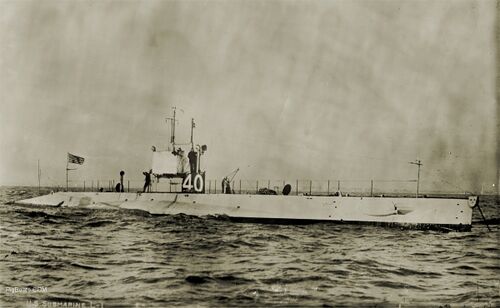
L-2 (Submarine No. 41, later SS-41)
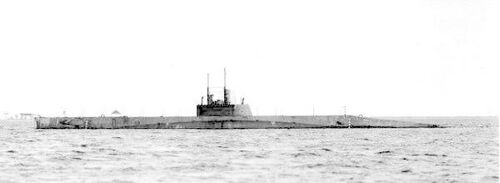
L-3 (Submarine No. 42, later SS-42)

L-4 (Submarine No. 43, later SS-43)

L-5 (Submarine No. 44, later SS-44)
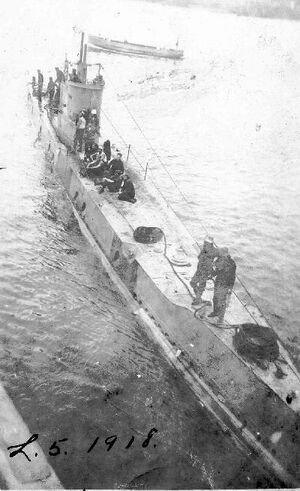
L-6 (Submarine No. 45, later SS-45)

L-7 (Submarine No. 46, later SS-46)

L-8 (Submarine No. 48, later SS-48)
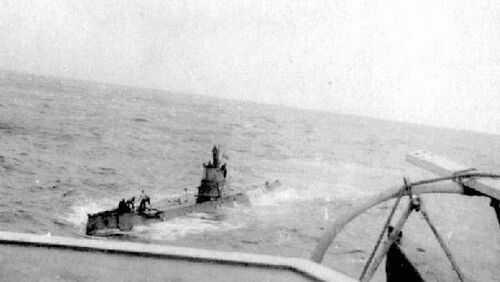
L-9 (Submarine No. 49, later SS-49)
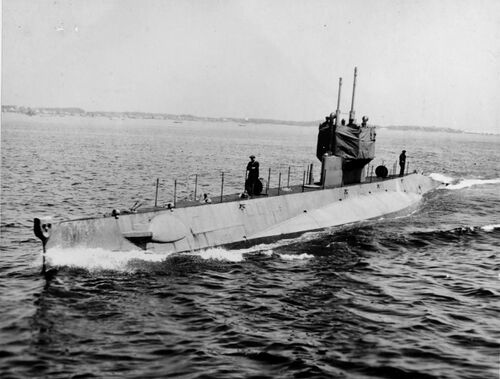
L-10 (Submarine No. 50, later SS-50)
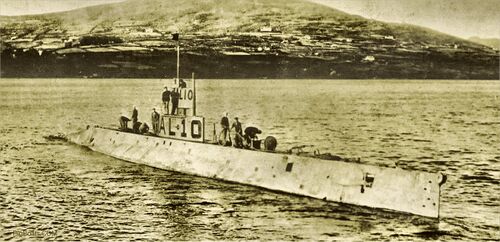
LT Vincent Arthur Clarke, Jr. was sent for submarine training at New London, Connecticut. Upon graduation he was assigned to submarine duty and sent to the Azores. From there he was made the commanding officer of the L-10, probably relieving LT Newbold T. Lawrence Jr. as CO. The L-10 operated out of Bantry Bay, Ireland for the duration of the war.
This command garnered Clarke a Navy Cross for his persistence in making the L-10 one of the "hot running boats" in WW I, racking up over 1700 hours out on patrol in pursuit of the enemy. War patrols in WW I were only an average of 10 days duration due to the sub's limits on food, water and fuel.
LT Clarke is probably the officer on the bridge in this photo as the L-10 backs away from her mooring. The crew look to be stowing the mooring lines in preparation for possibly heading out on a war patrol looking for German submarines.
L-11 (Submarine No. 51, later SS-51)
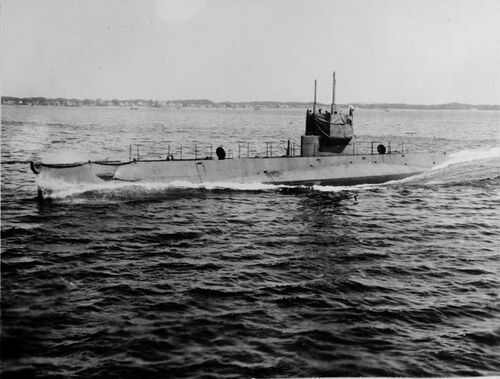
General L-class & group photos
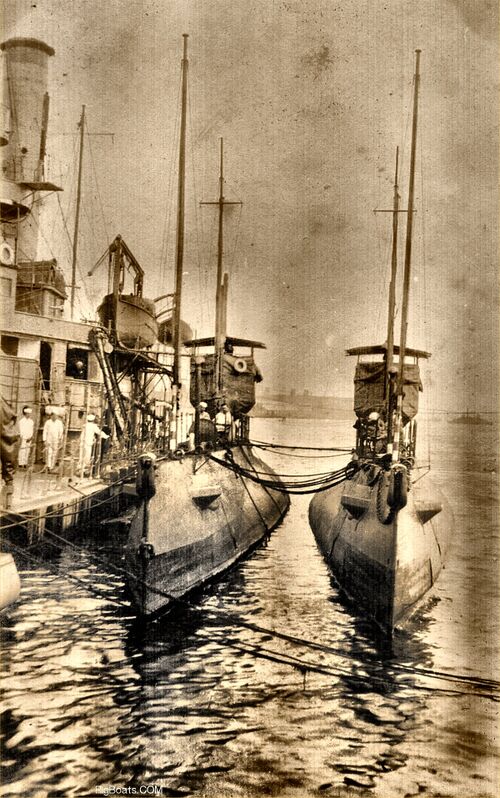
Both submarines have a tall forward radio mast. In looking in other archives we have seen only the L-1 with such a mast. So, possibly one of these two vessels could be the L-1 but it could just be coincidence that there only exists one image, other than this one, with these masts. Radio was new and trials were being made all the time.
Neither submarine have any sign of having SC tube listening gear installed at this point. So, a possible date is closer to commissioning, perhaps a late 1916 or early 1917. But for sure this is before the U.S. entered WW I on April 6, 1917. The submarines still are using the old-fashioned pre-war canvas bridge shelters that proved too flimsy to withstand the pressures of diving with it erected. They were too time consuming to try and take down in actual war time conditions.
The British, having been at war with Germany for two years, taught their American cousins a lot of practical things about actual submarine warfare including the development and use of the metal chariot bridge surround that could remain in place while diving and withstand those pressures. Soon almost all U.S. submarines had this revision installed.
Once these subs reached Europe, the British, to avoid confusing their L-class submarines with the American L-class, required the Americans to paint an "A" in front of their numbers. All combatants still wore hull identification at this time. In later conflicts all ID was painted out so an enemy could not keep track of sub movements, this is even done to this day.
These two submarines are moored to a monitor-type tender that is also not identified but could possibly be the USS Tonopah (BM-8). Three sailors are standing on the tender's deck. There also seem to be at least two people each on the submarine's decks.
Page created by:
Ric Hedman & David Johnston
1999 - 2023 - PigBoats.COM©
Mountlake Terrace, WA, Norfolk, VA
webmaster at pigboats dot com